CITIC Metal to invest an additional C$612 million ($454 million) in
Ivanhoe Mines at C$3.98 per share to fast track production
at the Kakula Copper Mine in D.R. Congo
New Kamoa North Bonanza Zone has an implied strike length
of 2.7 kilometres of shallow, thick, massive sulphide
mineralization, with copper grades up to 18.48% over 13.6 metres
TORONTO, CANADA ‒ Ivanhoe Mines (TSX: IVN; OTCQX: IVPAF) today announced its financial results for the quarter ended March 31, 2019. All figures are in U.S. dollars unless otherwise stated. Ivanhoe Mines is a Canadian mining company focused on advancing its three mine-development projects in Southern Africa: the Platreef palladium-platinum-nickel-copper-gold-rhodium discovery in South Africa; the Kamoa-Kakula copper discovery in the Democratic Republic of Congo (DRC); and the extensive upgrading of the historic Kipushi zinc-copper-lead-germanium mine, also in the DRC. The company also is exploring for new copper discoveries on its wholly-owned Western Foreland exploration licences, adjacent to the Kamoa-Kakula mining licence.
HIGHLIGHTS
- On April 25, 2019, China-based CITIC Metal agreed to invest an additional C$612 million ($454 million) in Ivanhoe by way of a private placement at C$3.98 per share, a premium of 29% over Ivanhoe’s share price at that time. The investment will be CITIC Metal’s second major financing in less than a year, bringing its total investment in Ivanhoe to $1 billion.
- The CITIC Metal investment is expected to close no later than September 7, 2019, much sooner than could be expected for a typical project-finance facility. The additional funds will allow Ivanhoe to fast track production at the Kakula Copper Mine.
- CITIC Metal, currently Ivanhoe Mines’ largest shareholder with a 19.3% ownership stake, will come to own 29.9% of Ivanhoe’s issued and outstanding common shares when the placement is completed. Robert Friedland will remain Ivanhoe’s second-largest shareholder.
- CITIC Metal’s existing standstill provision will be amended to a maximum ownership stake of 29.9% and extended until January 8, 2023 to provide sufficient time to bring the Kakula mine to production, and to advance subsequent, planned expansions at Kamoa-Kakula, and production at the Kipushi and Platreef projects. Ivanhoe’s entire shareholder base is expected to benefit from the economic growth and significant cash flows that result from commercial production at three mines.
- On May 2, 2019, Ivanhoe announced assays from ten new drill holes at the latest high-grade discovery at Kamoa-Kakula ─ the Kamoa North Bonanza Zone. Multiple, thick drill intercepts of more than 10% copper were recorded at the new discovery, including 18.48% copper over 13.6 metres.
- The Kamoa North Bonanza Zone has been extended to at least 350 metres, with an implied strike length of at least 2.7 kilometres. Four rigs are drilling at Kamoa North to delineate the extent of the discovery and assess its potential to be fast-tracked to production.
- Any material mined at Kamoa North could be processed at a nearby, standalone plant, or hauled to the plant that will be constructed at Kakula. This has the potential of significantly increasing the copper grades during the initial stages of production at Kamoa-Kakula.
- The controlling east-west striking fault responsible for the massive copper sulphide mineralization in the Kamoa North Bonanza Zone is visible on airborne magnetic images and can be traced over a distance length of at least 10 to 20 kilometres. It trends west onto the adjacent Western Foreland exploration licences that are 100%-owned by Ivanhoe Mines.
- In the far northern portion of the Kamoa-Kakula’s mining licence, the Kamoa geology team has been drill testing the shallow, high-grade copper trend and has successfully followed it to within 15 metres of the northern boundary of the Kamoa-Kakula mining licence.
- Development at the underground Kakula Mine, the first of multiple, planned mining areas at Kamoa-Kakula, is making steady progress. Construction of the twin northern declines has been completed and underground development activities now are focused on constructing lateral access drives. In addition, development of a ventilation and access decline on the southern side of the Kakula orebody is underway and construction of the mine’s first ventilation shaft is progressing.
- Other engineering and construction activities underway at Kamoa-Kakula include construction of a permanent road between the mine site and the Kolwezi airport, construction of the first phase of accommodations for 1,000 employees and contractors, and earthworks for the processing plant.
- On February 6, 2019, Ivanhoe announced an independent pre-feasibility study (PFS) for the Kakula Mine. The stage one, 6 Mtpa operation, with estimated development capital of $1.1 billion, yields an after-tax NPV8% of $5.4 billion and an IRR of 47% over a 25-year mine life. Initial production is scheduled for early 2021, and the mine is expected to average 6.8% copper over the first five years, with mine-site cash costs of $0.43 per pound of copper.
- Ivanhoe also announced an updated independent preliminary economic assessment (PEA) for an expanded Kakula-Kamoa production rate of 18 Mtpa, supplied initially by a 6 Mtpa mine at Kakula, followed by two 6 Mtpa mines at Kansoko and Kakula West, and a direct-to-blister smelter. The PEA envisions the staged mine expansions and smelter will be funded from internal cash flows and yields an after-tax NPV8% of $10.0 billion and an IRR of 41%. All figures in the PFS and PEA are on a 100%-project basis.
- Once the expanded PEA production rate of 18 Mtpa is achieved, Kamoa-Kakula is projected to become the world’s second largest copper mine, with peak annual production of more than 700,000 tonnes of copper.
- Ivanhoe’s DRC exploration team is continuing with its regional drilling program targeting Kamoa-Kakula-style copper mineralization in the Western Foreland region, just to the west of the Kamoa-Kakula mining-licence area. The projected extensions of the Kamoa North Bonanza Zone and the Kamoa Far North high-grade corridor onto the Western Foreland licences are two new, high-priority exploration targets.
- In July 2018, Ivanhoe announced a new Mineral Resource estimate for the Kipushi Mine in the DRC that increased zinc-rich Measured and Indicated Mineral Resources to 11.8 million tonnes at an average grade of 35.3% zinc.
- The updated Mineral Resource will be used in the preparation of the Kipushi definitive feasibility study (DFS). The DFS, which will update and refine the findings of the PFS issued in December 2017, is nearing completion. Similar to the PFS, the DFS will focus on the initial mining of Kipushi’s Big Zinc Zone.
- Discussions are continuing with potential strategic partners and lenders to support Ivanhoe’s continuing advance toward a new era of production at Kipushi. Ivanhoe has made significant progress in upgrading the mine’s underground infrastructure and the company now has a much clearer path to a resumption of production from the high-grade Big Zinc orebody.
- At the Platreef palladium-platinum-nickel-copper-gold-rhodium mine development project in South Africa, the project’s first shaft (Shaft 1) has been extended to a depth of 855 metres below surface. The 850-metre-level station was approximately 70% complete at the end of March 2019.
- The 850-metre-level station, as well as the already completed 750-metre-level, will provide underground access to the high-grade orebody, enabling mine development to proceed. As sinking of Shaft 1 advances, one more station will be developed at a depth of 950 metres. Shaft 1 is expected to reach its projected, final depth of 982 metres below surface in early 2020.
- Surface construction for Platreef’s Shaft 2 is focused on the concrete foundation (hitch) for the headframe, which is expected to be completed by mid-2019. Shaft 2 will have an internal diameter of 10 metres and will be equipped with two 40-tonne rock-hoisting skips with a capacity to hoist a total of six million tonnes of ore per year – the single largest hoisting capacity at any mine in Africa.
- Ivanhoe continues to advance the arrangement of project financing for the development of the Platreef Project with a syndicate of international banks. Discussions also are underway with leading South African financial institutions regarding the financing of the black economic empowerment partners’ contribution to the development capital, which would reduce the amount that would have to be contributed by Ivanhoe on their behalf.
- Ivanhoe is investigating an alternative production plan for the Platreef Project, targeting significantly lower initial capital, to accelerate first production by using Shaft 1 as the mine’s initial production shaft.
- On May 1, Ivanhoe announced that Lars-Eric Johansson, who has served as Ivanhoe’s President and Chief Executive Officer since May 2007, will retire at the end of June 2019.
- Also on May 1, Ivanhoe announced the appointment of Tony Giardini as its new President. Mr. Giardini’s extensive experience as a senior-level finance and mining executive positions him well to oversee the construction and operation of Ivanhoe’s three mine development projects. Mr. Johansson will work alongside Mr. Giardini until the end of June to ensure a smooth and seamless transition.
- On April 25, Ivanhoe announced the establishment of a long-term relationship with innovative, privately-held, technology and metals company, High Power Exploration (HPX). Ivanhoe agreed to provide HPX with a $50 million secured loan facility, convertible into HPX shares or at least a 25% interest in an HPX Tier One copper-gold exploration and development project in the United States. HPX agreed to provide Ivanhoe with access to its proprietary suite of exploration hardware and software for Ivanhoe’s use in exploration activities in Southern Africa.
- At the end of Q1 2019, Kamoa-Kakula had recorded 13.4 million work hours free of lost-time injuries, Kipushi 457,458 work hours free of lost-time injuries, and Platreef 1.3 million work hours free of lost-time injuries.
On April 25, 2019 CITIC Metal agreed to invest an additional C$612 million ($454 million) in Ivanhoe Mines at C$3.98 per share, bringing its investment in Ivanhoe to $1 billion. Left to right: Peter Zhou (Vice President, Corporate Development, Asia, Ivanhoe Mines), Yufeng “Miles” Sun (President, CITIC Metal Group / Chairman, CITIC Resources Holdings / Co-Chairman, Ivanhoe Mines), Robert Friedland (Executive Co-Chairman, Ivanhoe Mines) and Manfu Ma (Vice President, CITIC Metal Group).
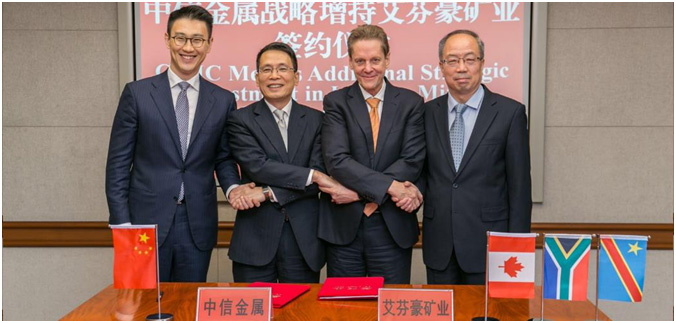
Principal projects and review of activities
1. Platreef Project
64%-owned by Ivanhoe Mines
South Africa
The Platreef Project is owned by Ivanplats (Pty) Ltd, which is 64%-owned by Ivanhoe Mines. A 26% interest is held by Ivanplats’ historically-disadvantaged, broad-based, black economic empowerment (B-BBEE) partners, which include 20 local host communities with approximately 150,000 people, project employees and local entrepreneurs.A Japanese consortium of ITOCHU Corporation; Japan Oil, Gas and Metals National Corporation and Japan Gas Corporation, owns a 10% interest in Ivanplats, which it acquired in two tranches for a total investment of $290 million.
The Platreef Project hosts an underground deposit of thick, platinum-group metals, nickel, copper and gold mineralization on the Northern Limb of the Bushveld Igneous Complex in Limpopo Province, approximately 280 kilometres northeast of Johannesburg and eight kilometres from the town of Mokopane.
On the Northern Limb, platinum-group metals mineralization is hosted primarily within the Platreef, a mineralized sequence that is traced more than 30 kilometres along strike. Ivanhoe’s Platreef Project, within the Platreef’s southern sector, is comprised of two contiguous properties: Turfspruit and Macalacaskop. Turfspruit, the northernmost property, is contiguous with, and along strike from, Anglo Platinum’s Mogalakwena group of mining operations and properties.
Since 2007, Ivanhoe has focused its exploration and development activities on defining and advancing the down-dip extension of its original discovery at Platreef, now known as the Flatreef Deposit, which is amenable to highly mechanized, underground mining methods. The Flatreef area lies entirely on the Turfspruit and Macalacaskop properties, which form part of the company’s mining right.
The Platreef Mine site, showing Shaft 1’s headframe and the box cut for Shaft 2.
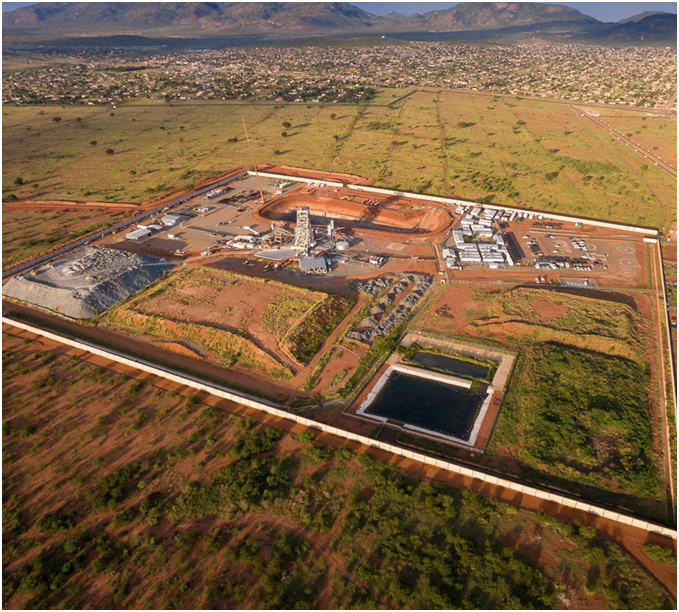
Health and safety at Platreef
As at the end of Q1 2019, the Platreef Project had reached a total of 1,305,357 lost-time, injury-free hours worked in accordance with South Africa’s Mine Health and Safety Act and Occupational Health and Safety Act. At the end of March 2019, it had been nearly twelve months since the last lost-time injury occurred at the Platreef Project, which continues to strive toward its workplace objective of an environment that causes zero harm to employees, contractors, sub-contractors and consultants.
Platreef alternative production plan
Ivanhoe Mines is investigating an alternative production plan for the Platreef Project, targeting significantly lower initial capital, to accelerate first production by using Shaft 1 as the mine’s initial production shaft. This plan will focus on initially targeting the development of mining zones accessible from Shaft 1 and maximizing the hoisting capacity of this shaft, followed by expansions to the production rate as outlined in the company’s 2017 definitive feasibility study (DFS).
Shaft 1 now extends to a depth of 855 metres below surface
Shaft 1 reached the top of the high-grade Flatreef Deposit (T1 mineralized zone) at a depth of 780.2 metres below surface in Q3 2018 and has since been extended to a depth of 855 metres below surface. The 850-metre-level station development is underway and was an estimated 70% complete at the end of March 2019. The thickness of the mineralized reef (T1 & T2 mineralized zones) at Shaft 1 is 29 metres, with grades of platinum-group metals ranging up to 11 grams per tonne (g/t) 3PE (platinum, palladium and rhodium) plus gold, as well as significant quantities of nickel and copper. The 29-metre intersection yielded approximately 3,000 tonnes of ore, estimated to contain more than 400 ounces of platinum-group metals. The ore is stockpiled on surface for metallurgical sampling.
The 750-metre-level and 850-metre-level stations will provide initial, underground access to the high-grade orebody, enabling mine development to proceed during the construction of Shaft 2. As sinking of Shaft 1 advances, one more station will be developed at a mine-working depth of 950 metres. Shaft 1 is expected to reach its projected, final depth of 982 metres below surface in early 2020.
The DFS planned for Shaft 1 to ultimately become the primary ventilation shaft during the project’s four-Mtpa production case.
Limpopo Premier Stanley Chupu Mathabatha (centre) cutting a ceremonial ribbon, alongside members of the Platreef shaft-sinking team, to signify the completion of the 850-metre top-cut station development.
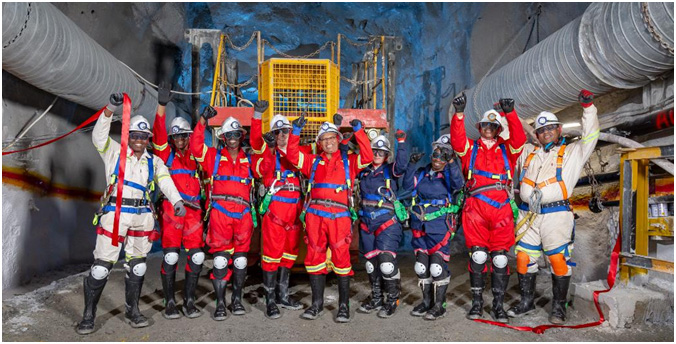
Shaft 2 early-works construction progressing
Shaft 2, to be located approximately 100 metres northeast of Shaft 1, will have an internal diameter of 10 metres. It will be lined with concrete and sunk to a planned, final depth of more than 1,104 metres below surface. It will be equipped with two, 40-tonne, rock-hoisting skips capable of hoisting a total of six million tonnes of ore a year – the single largest hoisting capacity at any mine in Africa.
The headgear for the permanent hoisting facility was designed by South Africa-based Murray & Roberts Cementation. Nine blasts were successfully completed in 2018 enabling the excavation of Shaft 2’s box cut to a depth of approximately 29 metres below surface and the construction of the concrete hitch (shaft collar foundation) for the 103-metre-tall concrete headgear that will house the shaft’s permanent hoisting facilities and support the shaft collar. Excavation of the box cut and construction of the hitch foundation is expected to be completed in June 2019, enabling the beginning of pre-sinking work that will extend the depth of the shaft to 84 metres below surface.
Figure 1: Schematic section of the Platreef Mine, showing Flatreef’s T1 and T2 thick, high-grade mineralized zones (red and dark orange), underground development work completed to date in shafts 1 and 2 (white) and planned development work (gray).
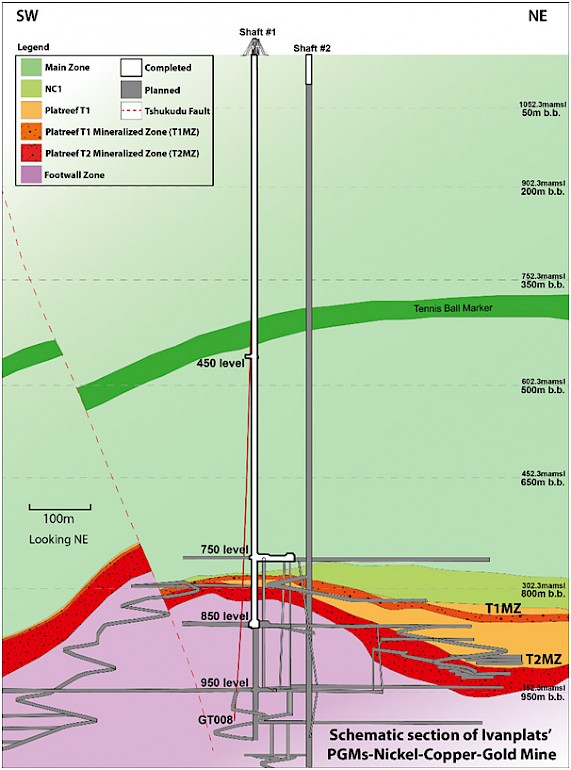
Ongoing construction of the foundation that will support Shaft 2’s 103-metre-tall concrete headframe.
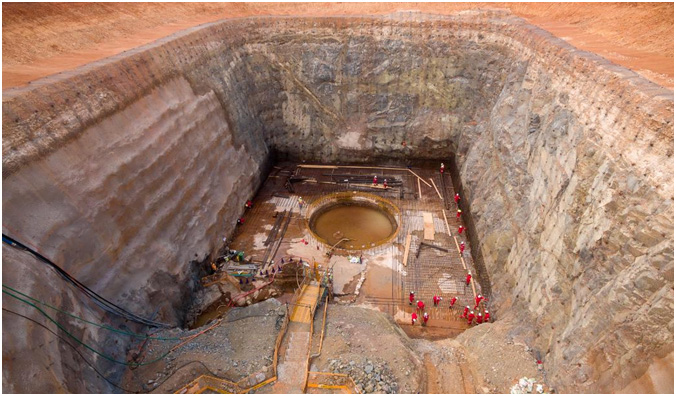
Underground mining to incorporate highly productive, mechanized methods
Ivanhoe plans to develop the Platreef Mine in phases. The initial production plans are designed to establish an operating platform to support future expansions. Production is expected to be increased to 8 Mtpa in subsequent phases, and then further increased to a steady-state 12 Mtpa phase, which would establish Platreef among the largest platinum-group-metals mines in the world.
The mining zones in the current Platreef mine plan occur at depths ranging from approximately 700 metres to 1,200 metres below surface.
Planned mining methods will use highly productive, mechanized methods, including long-hole stoping and drift-and-fill mining. Each method will utilize cemented backfill for maximum ore extraction. As per the DFS, the ore will be hauled from the stopes to a series of internal ore passes and fed to the bottom of Shaft 2, where it will be crushed and hoisted to surface.
Platreef project financing continuing to advance
Ivanhoe continues to advance the arrangement of project financing for the development of the Platreef Project with a syndicate of international banks.
In addition, preliminary discussions are underway with leading South African financial institutions regarding the financing of the black economic empowerment partners’ contribution to the development capital which would thereby reduce the amount that would otherwise have to be contributed by Ivanhoe on their behalf.
Long-term supply of bulk water secured for the Platreef Mine
On May 7, 2018, Ivanhoe announced the signing of a new agreement to receive local, treated water to supply most of the bulk water needed for the first phase of production at Platreef. The Mogalakwena Local Municipality has agreed to supply a minimum of five million litres of treated water a day for 32 years, beginning in 2022, from the town of Mokopane’s new Masodi Treatment Works. Initial supply will be used in Platreef’s ongoing underground mine development and surface infrastructure construction.
Under terms of the agreement, which is subject to certain suspensive conditions, Ivanplats will provide financial assistance to the municipality for certified costs of up to a maximum of R248 million (approximately $19.6 million) to complete the Masodi treatment plant. Ivanplats will purchase the treated wastewater at a reduced rate of R5 per thousand litres for the first 10 million litres per day to offset a portion of the initial capital contributed.
Ivanplats received its Integrated Water Use Licence in January 2019, which is valid for 30 years and enables the Platreef Project to make use of water as planned in the 2017 DFS.
Anthony Baloyi, Mokopane Micraas, Abatian Manmela and Ruddy Malete (left to right), of South Africa-based Malecombo Steel Fixers, installing steel rebar for Shaft 2’s concrete foundation, which is expected to be completed in June 2019.
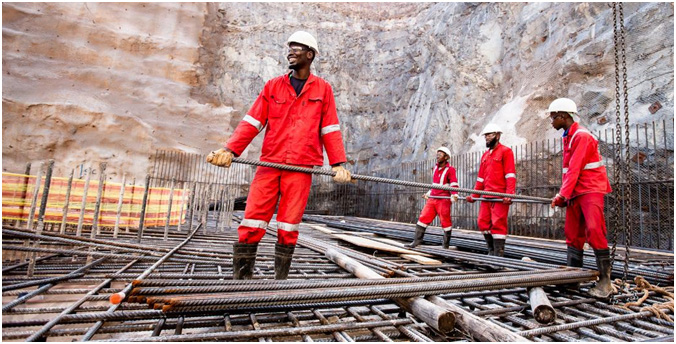
Development of human resources and job skills
Work has progressed on the implementation of Ivanhoe’s Social and Labour Plan (SLP). The Company has pledged a total of R160 million ($11 million) during the first five years, culminating in November 2019, of which R110 million ($8 million) already had been spent by March 2019. The approved plan includes R67 million ($5 million) for the development of job skills among local residents and R88 million ($6 million) for local economic development projects.
On April 1, 2019, a ceremony was held at Masodi Secondary School where recipients of the Ivanplats Scholarship Program received new uniforms and school supplies.
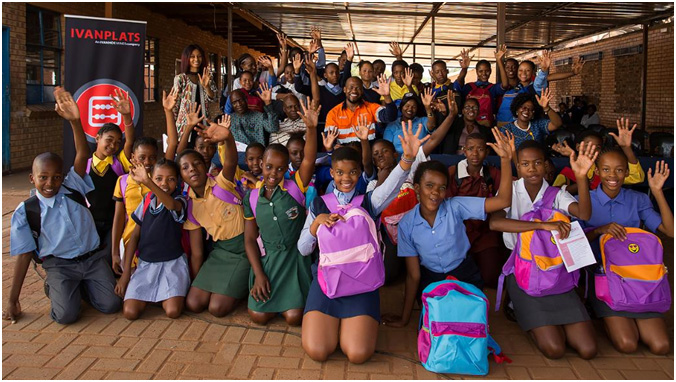
2. Kipushi Project
68%-owned by Ivanhoe Mines
Democratic Republic of Congo
The Kipushi copper-zinc-germanium-lead mine, in the Democratic Republic of Congo, is adjacent to the town of Kipushi and approximately 30 kilometres southwest of Lubumbashi. It is located on the Central African Copperbelt, approximately 250 kilometres southeast of the Kamoa-Kakula Project and less than one kilometre from the Zambian border. Ivanhoe acquired its 68% interest in the Kipushi Project in November 2011; the balance of 32% is held by the state-owned mining company, La Générale des Carrières et des Mines (Gécamines).
Health, safety and community development
At the end of Q1 2019, the Kipushi Project reached a total of 457,458 work hours free of lost-time injuries. It has been more than four months since the last lost-time injury occurred at the Kipushi Project.
The Kipushi Project operates a potable-water station to supply the municipality with water. This includes power supply, disinfectant chemicals, routine maintenance, security and emergency repair of leaks to the primary reticulation. The Kipushi Project also installed and commissioned new overhead powerlines to the pump station. Other community development projects continued during Q1 2019 and included a new enrolment into the Kipushi women’s literacy project and the continuation of the sewing training centre project.
Figure 2: Schematic underground section of the Kipushi Mine.
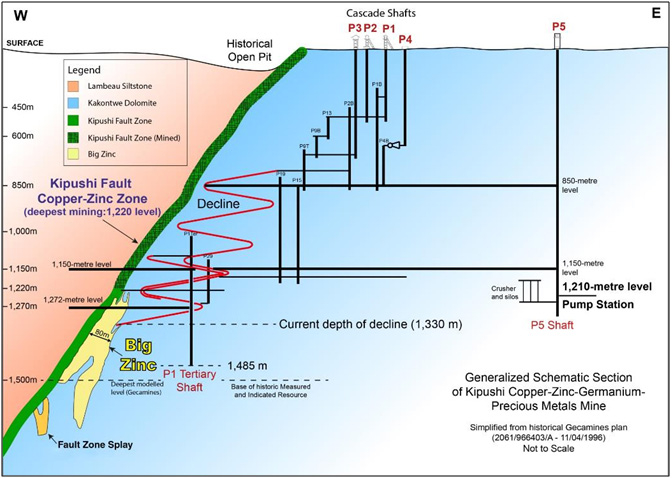
Pre-feasibility study for Kipushi completed in December 2017; definitive feasibility study nearing completion
The Kipushi Project’s PFS, announced by Ivanhoe Mines on December 13, 2017, anticipated annual production of an average of 381,000 tonnes of zinc concentrate over an 11-year, initial mine life at a total cash cost of approximately $0.48 per pound (lb) of zinc.
Highlights of the PFS, based on a long-term zinc price of $1.10/lb include:
- After-tax net present value (NPV) at an 8% real discount rate of $683 million.
- After-tax real internal rate of return (IRR) of 35.3%.
- After-tax project payback period of 2.2 years.
- Pre-production capital costs, including contingency, estimated at $337 million.
- Existing surface and underground infrastructure allows for significantly lower capital costs than comparable greenfield development projects.
- Life-of-mine average planned zinc concentrate production of 381,000 dry tonnes per annum, with a concentrate grade of 59% zinc, is expected to rank Kipushi, once in production, among the world’s largest zinc mines.
All figures are on a 100%-project basis unless otherwise stated. Estimated life-of-mine average cash cost of $0.48/lb of zinc is expected to rank Kipushi, once in production, in the bottom quartile of the cash-cost curve for zinc producers internationally.
The planned primary mining method for the Big Zinc Deposit in the PFS is sublevel long-hole, open stoping, with cemented backfill. The crown pillars are expected to be mined once adjacent stopes are backfilled using a pillar-retreat mining method. The Big Zinc Deposit is expected to be accessed via the existing decline and without any significant new development. The main levels are planned to be at 60-metre vertical intervals, with sublevels at 30-metre intervals.
The Kipushi Project’s DFS is nearing completion and will incorporate the updated Mineral Resource estimate of June 14, 2018.
Start-up and testing of the five, high-capacity pumps at Kipushi’s upgraded water-pumping station on the 1,210-metre level.
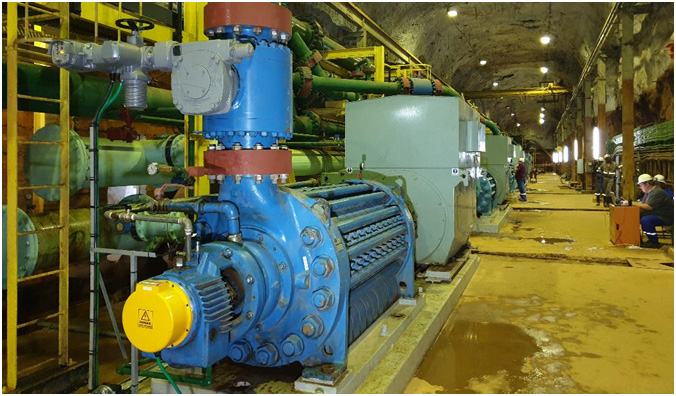
Project development and infrastructure
Significant progress has been made in modernizing the Kipushi Mine’s underground infrastructure as part of preparations for the mine to resume commercial production, including upgrading a series of vertical mine shafts to various depths, with associated head frames, as well as underground mine excavations and infrastructure.
A series of crosscuts and ventilation infrastructure still is in working condition and have been cleared of old materials and equipment to facilitate modern, mechanized mining. The underground infrastructure upgrades also includes a series of pumps to manage the mine’s water levels, which now are easily maintained at the bottom of the mine.
Shaft 5 is eight metres in diameter and 1,240 metres deep. It now has been upgraded and re-commissioned. The main personnel and material winder has been upgraded and modernized to meet international industry standards and safety criteria. The Shaft 5 rock-hoisting winder now is fully operational with new rock skips, new head- and tail-ropes, and attachments installed. The two newly manufactured rock conveyances (skips) and the supporting frames (bridles) have been installed in the shaft to facilitate the hoisting of rock from the main ore and waste storage silos feeding rock on the 1,200-metre level.
The main haulage way on the 1,150-metre level between the Big Zinc access decline and Shaft 5 rock load-out facilities has been resurfaced with concrete so the mine now can use modern, trackless, mobile machinery. A new truck-tipping bin, which feeds into the large-capacity rock crusher located directly below, has been installed on this level.
With the underground upgrading program nearing completion, the project’s focus now will shift to upgrading Kipushi’s surface infrastructure to handle and process Kipushi’s high-grade zinc and copper resources.
The new truck-tipping bin on Kipushi’s 1,150-metre level. Ore from the Big Zinc Deposit will be trucked here, then dumped into the bin, which feeds into the large-capacity rock crusher located directly below.
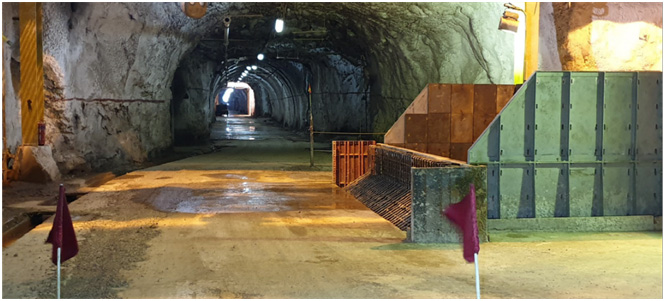
Kahudi Mununga connecting up a new hydraulic power pack for the brakes on Kipushi’s P3 hoist.
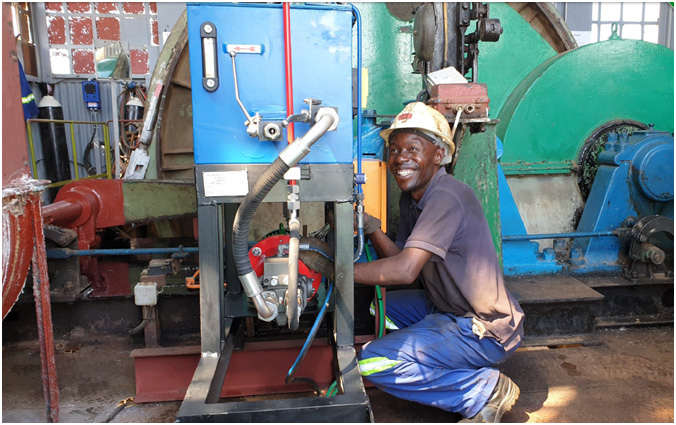
3. Kamoa-Kakula Project
39.6%-owned by Ivanhoe Mines
Democratic Republic of Congo
The Kamoa-Kakula Project, a joint venture between Ivanhoe Mines and Zijin Mining, has been independently ranked as the world’s fourth largest copper deposit by international mining consultant Wood Mackenzie, with adjacent prospective exploration areas within the Central African Copperbelt in the Democratic Republic of Congo, approximately 25 kilometres west of the town of Kolwezi and about 270 kilometres west of Lubumbashi.
Ivanhoe sold a 49.5% share interest in Kamoa Holding to Zijin Mining in December 2015 for an aggregate consideration of $412 million. In addition, Ivanhoe sold a 1% share interest in Kamoa Holding to privately-owned Crystal River for $8.32 million – which Crystal River will pay through a non-interest-bearing, 10-year promissory note. Since the conclusion of the Zijin transaction in December 2015, each shareholder has been required to fund expenditures at the Kamoa-Kakula Project in an amount equivalent to its proportionate shareholding interest in Kamoa Holding.
A 5%, non-dilutable interest in the Kamoa-Kakula Project was transferred to the DRC government on September 11, 2012 for no consideration, pursuant to the 2002 DRC mining code. Following the signing of an agreement with the DRC government in November 2016, in which an additional 15% interest in the Kamoa-Kakula Project was transferred to the DRC government, Ivanhoe and Zijin Mining now each hold an indirect 39.6% interest in the Kamoa-Kakula Project, Crystal River holds an indirect 0.8% interest and the DRC government holds a direct 20% interest. Kamoa Holding holds an 80% interest in the project.
View of Kamoa Copper’s camp and offices, looking east toward Kolwezi.
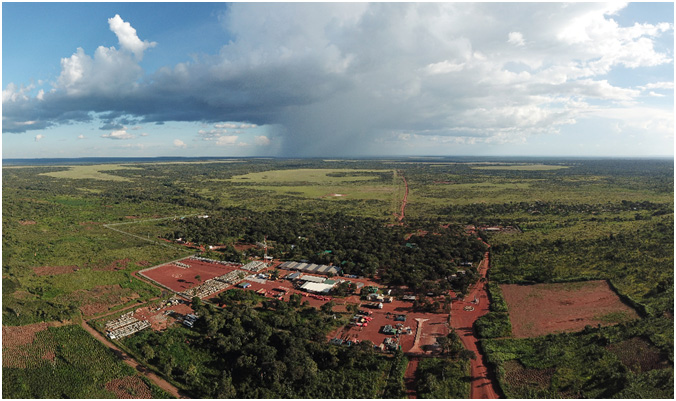
Kamoa-Kakula surpasses 13 million hours worked without a lost-time injury
At the end of Q1 2019, the Kamoa-Kakula Project had achieved a total of 13,399,799 work hours free of lost-time injuries. It has been approximately seven years since the last lost-time injury occurred at the project. This outstanding achievement reflects the dedication to a safety-focused culture of the entire Kamoa-Kakula exploration and development teams.
PFS for Kakula and updated PEA for an expanded Kamoa-Kakula production rate of 18 Mtpa announced
On February 6, 2019, Ivanhoe announced the results from the Kakula 2019 PFS. The study assesses the potential development of the Kakula Deposit as a 6 Mtpa mining and processing complex. The Kakula mill would be constructed in two smaller phases of 3 Mtpa each as the mining operations ramp-up to full production of 6 Mtpa. The life-of-mine production scenario provides for 119.7 million tonnes to be mined at an average grade of 5.48% copper, producing 9.8 million tonnes of high-grade copper concentrate, containing approximately 12.4 billion pounds of copper. All figures are on a 100%-project basis unless otherwise stated.
On March 22, 2019, Ivanhoe filed an updated NI 43-101 technical report for the Kamoa-Kakula Copper Project covering the independent pre-feasibility studies for the development of the Kakula and Kansoko copper mines, and an updated, expanded preliminary economic assessment for the overall integrated development plan for the project. The report, titled “Kamoa-Kakula Integrated Development Plan 2019”, is available on the company’s website and under the company’s SEDAR profile at www.sedar.com.
Highlights of the PFS, based on a consensus, long-term copper price of $3.10/lb include:
- Very high-grade, stage-one production is projected to have a grade of 7.1% copper in the second year of production and an average grade of 6.4% copper over the initial 10 years of operations, resulting in estimated average annual copper production of 291,000 tonnes.
- Annual copper production is estimated at 360,000 tonnes in year four.
- Initial capital cost, including contingency, is estimated at $1.1 billion.
- Average total cash cost of $1.11/lb of copper during the first 10 years, inclusive of royalties.
- After-tax NPV, at an 8% discount rate, of $5.4 billion.
- After-tax internal rate of return (IRR) of 46.9%, and a payback period of 2.6 years.
- Kakula is expected to produce a very high-grade copper concentrate in excess of 55% copper, with extremely low arsenic levels.
Ivanhoe also announced an updated independent PEA for an expanded Kakula-Kamoa production rate of 18 Mtpa, supplied initially by a 6 Mtpa mine at Kakula, followed by two 6 Mtpa mines at Kansoko and Kakula West, and a world-scale direct-to-blister smelter.
Highlights of the PEA, based on a consensus, long-term copper price of $3.10/lb include:
- Very high-grade initial phase projected to have a grade of 7.1% copper in the second year of production and an average grade of 5.7% copper during the first 10 years of operations, resulting in estimated average annual copper production of 386,000 tonnes.
- Recovered copper production is estimated at 740,000 tonnes in year 12, which would rank the Kamoa-Kakula Project as the second largest copper producer in the world.
- Initial capital cost, including contingency, is $1.1 billion, with subsequent expansions at Kansoko, Kakula West, and other mining areas, as well as the smelter, to be funded by cash flows from the Kakula Mine.
- Average total cash costs of $0.93/lb of copper during the first 10 years, including sulphuric acid credits.
- After-tax NPV, at an 8% discount rate, of $10.0 billion.
- After-tax IRR of 40.9% and a payback period of 2.9 years.
Figure 3: Kamoa-Kakula 18 Mtpa PEA long-term development plan.
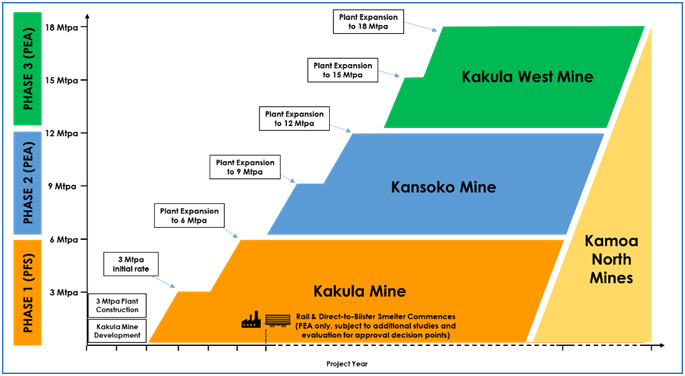
Figure by OreWin 2019.
Figure 4: Projected 18 Mtpa Kamoa-Kakula PEA production (year-12 peak copper production shown) compared to the world’s projected top 20 producing mines in 2025 by paid copper production.
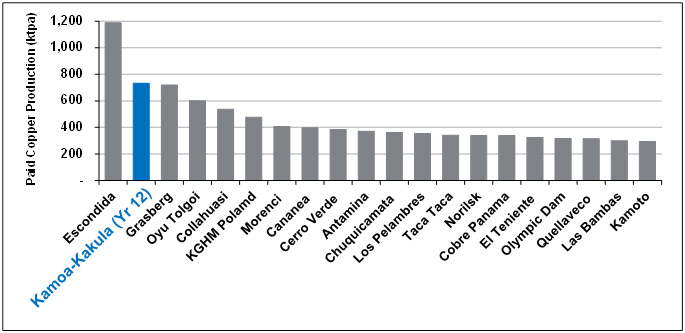
Note: Kamoa-Kakula 2019 PEA production based on projected peak copper production (which occurs in year 12) of the 18 Mtpa alternative development option.
Source: Wood Mackenzie (based on public disclosure, the Kakula 2019 PFS has not been reviewed by Wood Mackenzie).
Kamoa-Kakula Mineral Resources
Ivanhoe issued an updated Mineral Resource estimate for the Kamoa-Kakula Project on February 6, 2019. Details of the updated Mineral Resource estimate are contained in the March 2019, independent NI 43-101 technical report for the Kamoa-Kakula Project.
The updated Mineral Resource estimate includes an updated Kakula Mineral Resource estimate and was prepared by Ivanhoe Mines under the direction of Amec Foster Wheeler E&C Services Inc. of Reno, USA, in accordance with the 2014 CIM Definition Standards for Mineral Resources and Mineral Reserves. The Qualified Persons for the 2019 Kamoa-Kakula Mineral Resource estimate are Dr. Harry Parker, RM, SME and Gordon Seibel, RM, SME both of Amec Foster Wheeler E&C Services Inc.
Indicated Mineral Resources for the combined Kamoa-Kakula Project now total 1,387 million tonnes grading 2.64% copper, containing 80.6 billion pounds of copper at a 1.0% copper cut-off grade and a minimum thickness of three metres. Kamoa-Kakula also has Inferred Mineral Resources of 316 million tonnes grading 1.76% copper and containing 12.2 billion pounds of copper, also at a 1.0% copper cut-off grade and a minimum thickness of three metres.
The Kakula Mineral Resource estimate covers a mineralized strike length of 13.3 kilometres and is based on results from 323 holes completed by November 1, 2018. Indicated Mineral Resources total 628 million tonnes at a grade of 2.72% copper, containing 37.6 billion pounds of copper at a 1% copper cut-off. At a 2% copper cut-off, Indicated Mineral Resources total 319 million tonnes at a 3.99% copper grade, containing 28.1 billion pounds of copper. At a 3% copper cut-off, Indicated Mineral Resources total 164 million tonnes at a grade of 5.50% copper, containing 19.9 billion pounds of copper.
Inferred Mineral Resources total 114 million tonnes at a grade of 1.59% copper, containing 4.0 billion pounds of copper at a 1% copper cut-off. At a 2% copper cut-off, Inferred Mineral Resources total 23 million tonnes at a 2.62% copper grade, containing 1.3 billion pounds of copper. At a 3% copper cut-off, Inferred Mineral Resources total 5.0 million tonnes at a grade of 3.52% copper, containing 0.4 billion pounds of copper.
The average true thickness of the selective mineralized zone (SMZ) at a 1% copper cut-off is 10.5 metres in the Indicated Mineral Resources area and 6.9 metres in the Inferred Mineral Resources area. At a higher 3% copper cut-off, the average true thickness of the SMZ is 4.9 metres in the Indicated Mineral Resources area and 3.9 metres in the Inferred Mineral Resources area.
The Kakula Mineral Resources are defined within a total area of 27.4 square kilometres at a 1% copper cut-off. At the same cut-off grade, the areal extent of Indicated Mineral Resources is 21.5 square kilometres and the areal extent of the Inferred Mineral Resources is 5.9 square kilometres.
Underground development progressing at the Kakula Deposit
Each of the twin declines on the northern side of the Kakula ore body were completed in Q1 2019 and the 1,050-metre-level decline bottom dam excavation is nearing completion. This dam will manage water inflows in the declines and the first permanent pumps and pipes will be installed in Q2 2019. The development of two access drives towards the ore body is well advanced, as well as the top and bottom access drives to the first truck-tipping area and Ventilation Shaft 1. Surface preparation for Ventilation Shaft 1 that will be constructed by raise boring, also is well advanced. The shaft will be 5.5 metres in diameter and 200 metres deep.
The detailed design for the truck-tripping area, where underground development ore will feed onto the conveyor system for transportation to surface, and the conveyor system for the main declines has been completed, and component manufacture is progressing well. The contract for the underground civil works has been awarded and tenders for the mechanical installation and erection are being adjudicated.
Development of the ventilation and access decline on the southern side of the ore body has started and the steel sets are currently being installed.
View of the Kakula Mine, looking south. Kakula’s main box cut and northern twin declines are in the front centre of the photo.
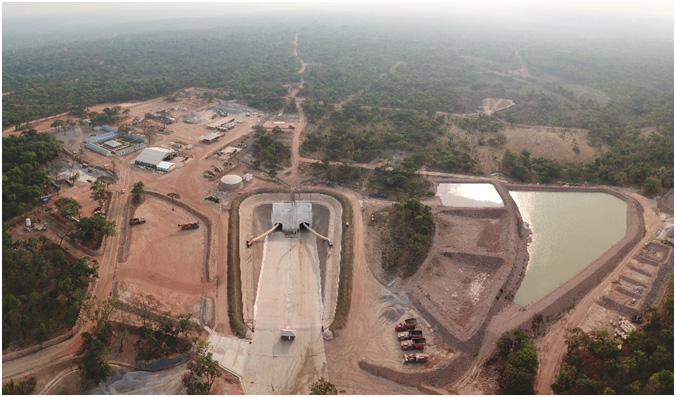
Figure 5: Kakula 2019 PFS mine development plan.
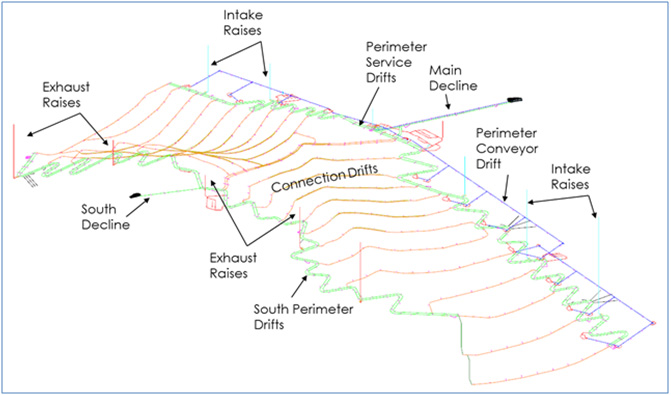
Figure by Stantec 2019.
Basic engineering, early works engineering and construction at Kakula
The basic engineering design is currently being carried out by DRA Global as the main contractor. Design of the plant and surface infrastructure is due to be completed by the end of Q2 2019, and the underground design in Q3 2019. The basic engineering package will advance engineering and provide a detailed capital cost estimate by which the project costs can be controlled.
Other early works engineering and construction activities that are currently underway include the construction of a permanent mine road joining the Kolwezi airport to the mine site, the construction of the first phase of the permanent mine village, consisting of accommodations for 1,000 employees and contractors, and earthworks for the processing plant and surface infrastructure.
Exploration extends strike length of the new, shallow, thick ‘Kamoa North Bonanza Zone’
Recent drilling has confirmed that the discovery zone of bonanza-grade copper mineralization at Kamoa North on the Kamoa-Kakula mining licence − the Kamoa North Bonanza Zone − is continuous over a strike length of at least 350 metres and a width of up to 60 metres. The mineralized zone, which was discovered earlier this year in drill hole DD1450, has an implied strike length of at least 2.7 kilometres and a drilled thickness of between six and 30 metres, and is approximately 170 to 220 metres below surface, with grades ranging as high as 18.48% copper over 13.6 metres, at both a 2% and a 3% cut-off grade.
Figure 6: Kamoa-Kakula mining licence (outlined in red) showing the new, high-grade discoveries at Kamoa North and Kamoa Far North relative to the Kakula and Kansoko mine sites. A portion of Ivanhoe’s adjoining, 100%-owned Western Foreland exploration licences is shown in grey.

The Kamoa North Bonanza Zone represents a new style of copper mineralization at Kamoa-Kakula, where massive to semi-massive chalcopyrite, bornite and chalcocite have locally replaced pyrite in the Kamoa Pyritic Siltstone (KPS) – a pyritic siltstone that lies immediately above the basal diamictite unit that typically hosts the copper mineralization at Kamoa-Kakula.
Assay results for 10 new holes were received from the Kamoa North drilling earlier this month, a complete list of which is available in Ivanhoe’s May 3 news release. Significant new drilling intercepts at the Kamoa North Bonanza Zone include:
-
- DD1486 intersected 16.70 metres of 15.84% copper, at a 3% and 2% copper cut-off, in semi-massive sulphide KPS-hosted mineralization, beginning at a downhole depth of 215 metres; and 17.46 metres of 15.21% copper at a 1% cut-off.
- DD1494 intersected 13.15 metres of 9.88% copper, at a 3%, 2% and 1% copper cut-off, in semi-massive sulphide KPS-hosted mineralization, beginning at a downhole depth of 215.50 metres.
- DD1497 intersected 13.60 metres of 18.48% copper, at a 3% and 2% copper cut-off, in semi-massive sulphide KPS-hosted mineralization, beginning at a downhole depth of 208.00 metres; and 30.37 metres of 8.90% copper at a 1% cut-off.
- DD1498 intersected 16.48 metres of 10.94% copper, at a 3% and 2% copper cut-off, in semi-massive sulphide KPS-hosted mineralization, beginning at a downhole depth of 222 metres; and 16.48 metres of 10.94% copper at a 1% cut-off.
- DD1499 intersected 16.93 metres of 11.31% copper, at a 3% copper cut-off, and 17.35 metres of 11.10% copper, at a 2% copper cut-off, in semi-massive sulphide KPS-hosted mineralization, beginning at a downhole depth of 205 metres; and 18.35 metres of 10.57% copper at a 1% cut-off.
- DD1504 intersected 21.25 metres of 13.32% copper, at a 3%, 2% and 1% copper cut-off, in semi-massive sulphide KPS-hosted mineralization, beginning at a downhole depth of 211.15 metres.
Figure 7: Copper grade profiles of two recent holes drilled at the Kamoa North Bonanza Zone, showing individual one-metre intervals of more than 46% copper.
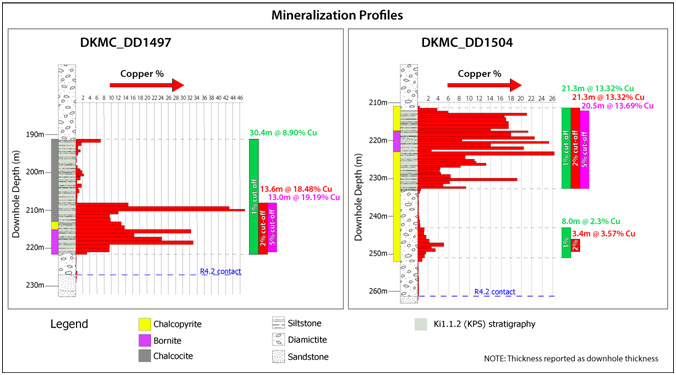
The Kamoa North Bonanza Zone remains open along a westerly-easterly strike for a considerable distance. An east-west lineament, thought to represent the controlling growth structure, can be traced in aeromagnetic data for up to 20 kilometres, across the western side of the Kamoa-Kakula Mining Licence and onto Ivanhoe’s adjoining, 100%-owned Western Foreland exploration licences.
The controlling east-west structure was previously intersected in holes DD0015, DD1200 and DD1396 that were drilled as part of an earlier, wide-spaced resource delineation drilling program. The recent, detailed drilling in the hole DD1450 discovery area has led Kamoa-Kakula geologists to consider that these earlier holes may have intercepted the same structure that hosts the KPS bonanza-grade copper, inferring a corridor of high-grade copper of at least 2.7 kilometres.
Drilling a step-out hole along strike at the Kamoa North Bonanza Zone.
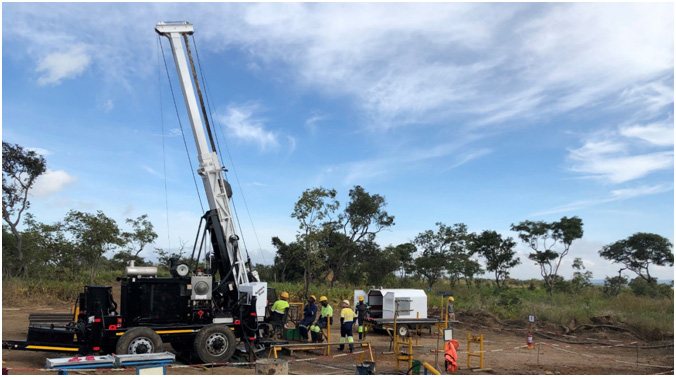
Geologists Lydia Makong (left) and Christelle Nkulu logging copper-rich drill core from the Kamoa North Bonanza Zone.
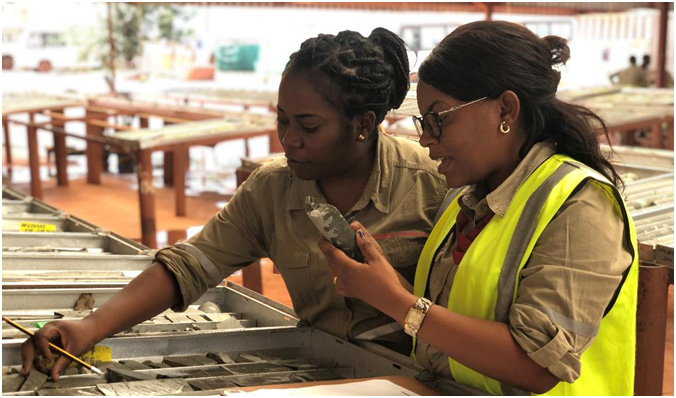
The potential to fast-track Kamoa North under initial assessment
Given the shallow depth, remarkable thickness and massive copper sulphide mineralization discovered within the Kamoa North Bonanza Zone, Kamoa-Kakula’s engineers are evaluating potential options to accelerate the development of this new discovery.
Based on the shallow depth of the high-grade mineralized intercepts to date at the Kamoa North Bonanza Zone, the discovery zone may be accessed by way of a surface box-cut and decline, similar to those at the Kakula and Kansoko deposits, in a relatively short time-frame.
Any material mined at Kamoa North could be processed at a nearby, standalone plant, or hauled to the plant that will be constructed at Kakula. This has the potential of significantly increasing the copper grades during the initial stages of production at Kamoa-Kakula.
Drilling extends the nine-kilometre corridor of shallow, high-grade copper at the Kamoa Far North discovery to the boundary of Ivanhoe’s 100%- owned Western Foreland exploration licences
Kamoa-Kakula geologists also are exploring another zone of shallow, high-grade copper mineralization in the far northern region of the Kamoa-Kakula mining licence. The Far North exploration target is the more typical stratiform mineralization characteristic of the majority of the Kamoa-Kakula copper deposits.
The high-grade copper zone at Kamoa Far North follows a north-south trend controlled by growth faulting and by the pinching out of the basal diamictite and the KPS against the Roan sandstone on the western flank of the Kamoa Dome. The pinching out results in the sulphide-rich upper portion of the diamictite and the KPS being brought into direct contact with the Roan Aquifer, resulting in the high copper grades seen at Kamoa Far North.
The mineralized corridor trends for more than nine kilometres and is projected to continue onto the adjacent Western Foreland exploration licences. The Kamoa geology team has been drill testing the high-grade trend to the north of Kamoa North and has successfully followed it to within 15 metres of the northern boundary of the Kamoa-Kakula mining licence. Assays from 11 holes are pending from drilling in this area.
Exploration drilling during Q1 2019 was split between Kakula West, Kamoa North and Kamoa Far North. Given the recent outstanding results from the Kamoa North Bonanza Zone, the focus of exploration now has shifted to Kamoa North with four rigs there to delineate the extent of the discovery and assess its potential to be fast-tracked to production to increase Kamoa-Kakula’s early copper grades.
Drilling for the first quarter was completed with a maximum of nine drill rigs. Excellent progress was seen on the rigs overall, despite challenging wet-season conditions. In total, 12,943 metres were completed in 35 holes, drilled by both contractors and project-owned rigs.
The seismic survey data from work completed in 2018 was processed and preliminary observations made. Additional ground gravity and ground mag survey programs were started in Kamoa North towards the end of Q1 2019, including a ground mag survey over the Kamoa North Bonanza Zone.
Figure 8: Kamoa Far North exploration area, showing the high-grade mineralized zone delineated to date.
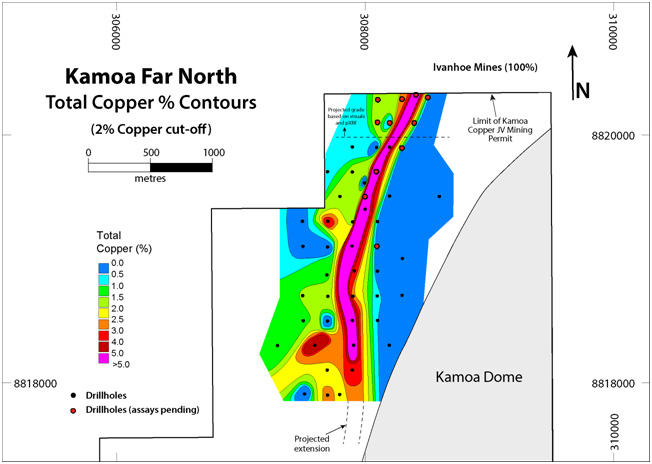
Ongoing upgrading work enables Mwadingusha hydropower station to supply
clean electricity to the national grid
Ongoing upgrading work at the Mwadingusha hydropower plant in the DRC has significantly progressed with the major equipment being delivered on site. The power station was shut down to replace sections of penstocks that were found to be in an advanced stage of corrosion. The progressive re-commissioning of the turbines, fully refurbished and modernized with state-of-the-art control and instrumentation, has recently commenced and is expected to be completed in Q3 2020. The refurbished plant is projected to deliver approximately 72 megawatts (MW) of power to the national power grid.
The work at Mwadingusha, part of a program to eventually overhaul and boost output from three hydropower plants, is being conducted by engineering firm Stucky of Lausanne, Switzerland, under the direction of Ivanhoe Mines and Zijin Mining, in conjunction with the DRC’s state-owned power company, La Société Nationale d’Electricité (SNEL). Once fully reconditioned, the three plants will have a combined installed capacity of approximately 200 MW of electricity for the national grid, which is expected to be more than sufficient for the Kamoa-Kakula Project.
The Kansoko Mine, Kakula Mine and Kamoa camp have been connected to the national hydroelectric power grid since the completion of a 12-kilometre, 120-kilovolt, dual-circuit power line between Kansoko and Kakula in December 2017. The design of permanent, 11-kilovolt reticulation to the vent shafts and mine has started, which includes substations, overhead lines and surface cables.
Continued focus on community and sustainability
The Kamoa-Kakula Sustainable Livelihoods Program is committed to sustainable development in the communities within the project’s footprint. The main objective of the livelihoods program is to enhance food security and the living standards of the people who reside within the project’s footprint. The program is mainly implemented through fish farming and food crops, including farming of maize (corn), vegetables and bananas, plus poultry production and beekeeping.
Additional non-farming related activities for Q1 2019 included education and literacy programs, the continuation of a community brick-making program, a basic training program, the construction of a school and housing for teachers, and the supply of fresh water to local communities.
Fabrice Mazeze with fresh tomatoes produced in the Ecolivelihood vegetable garden. The initiative is part of Kamoa-Kakula’s program to support and expand food production in nearby communities.
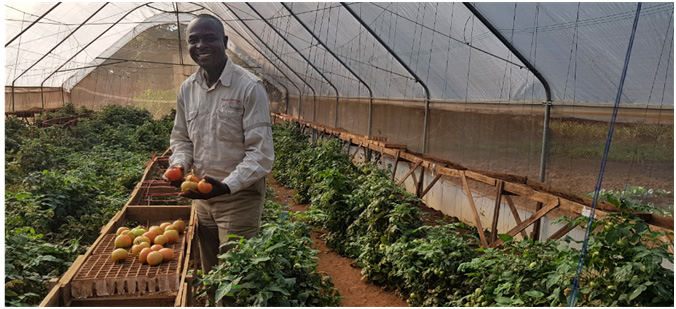
4.Western Foreland Exploration Project
100%-owned by Ivanhoe Mines
Democratic Republic of Congo
Ivanhoe’s DRC exploration group is targeting Kamoa-Kakula-style copper mineralization through a regional drilling program on its 100%-owned Western Foreland exploration licences, located to the north, south and west of the Kamoa-Kakula Project.
During Q1 2019, exploration drilling continued in the Makoko area with three rigs, one contractor rig and two project-owned Toyota Land Cruiser mounted (LC) rigs. A total of 5,320 metres were completed in 17 diamond drill holes during the quarter. Ten holes were drilled by the project-owned rigs for a total of 1,289 metres, while seven holes were drilled by a contractor rig for a total of 4,031 metres.
The contractor rig, drilling deeper holes, concentrated on infill holes for geotechnical and metallurgical studies as well as testing the western and eastern limits of the currently defined Makoko system. To the north, up-dip of Makoko, Ivanhoe used two project-owned drill rigs, to test the up-dip limit of the Nguba (host) stratigraphy along the basin margin, as well as the limit of the Roan sub basin associated with mineralization.
Processing of seismic data has been ongoing through Q1 2019. The 2D sections are being combined with detailed ground gravity data, airborne magnetics and drilling data to create a predicted geological interpretation from Kakula to Makoko. This work is providing an intricate insight into the behaviour of the mineralizing system in the Western Foreland.
The projected extensions of the Kamoa North Bonanza Zone and the Kamoa Far North high-grade discovery onto the Western Foreland licences are two high-priority exploration targets that Ivanhoe plans to target in its future drilling campaigns.
Ground gravity and magnetic surveys are ongoing at Kamoa North and on the Western Foreland licences in an attempt to pick up growth faults, basin structures (transfer faults) and potentially stratigraphic changes in the target areas The Kamoa North work is essentially complete and is being interpreted by the Ivanhoe exploration team.
Makoko Copper Discovery
On October 1, 2018, Ivanhoe announced the Makoko Copper Discovery on its 100%-owned Western Foreland exploration licences, near Kamoa-Kakula. The Makoko Discovery is Ivanhoe’s third major copper discovery in the DRC and shows characteristics identical to Ivanhoe’s tier-one Kamoa-Kakula discoveries.
The initial discovery hole at Makoko, DD004, was drilled in September 2017, with follow-up and infill drilling ongoing since that time. Drilling to date at Makoko has defined a flat-lying, near-surface stratiform copper deposit, similar to the Kamoa and Kakula deposits. The structure contour map indicates that the mineralized formation in the Makoko area is within 1,000 metres of surface.
The majority of the drilling to date at Makoko has intersected the copper-rich zone between 400 metres and 800 metres below surface. The mineralized zone at Makoko strikes approximately south-southeast. It has been tested over a strike length of 4.5 kilometres and a dip extent of between one and two kilometres. Copper mineralization remains open both along strike and down dip.
Selected quarterly financial information
The following table summarizes selected financial information for the prior eight quarters. Ivanhoe had no operating revenue in any financial reporting period and did not declare or pay any dividend or distribution in any financial reporting period.
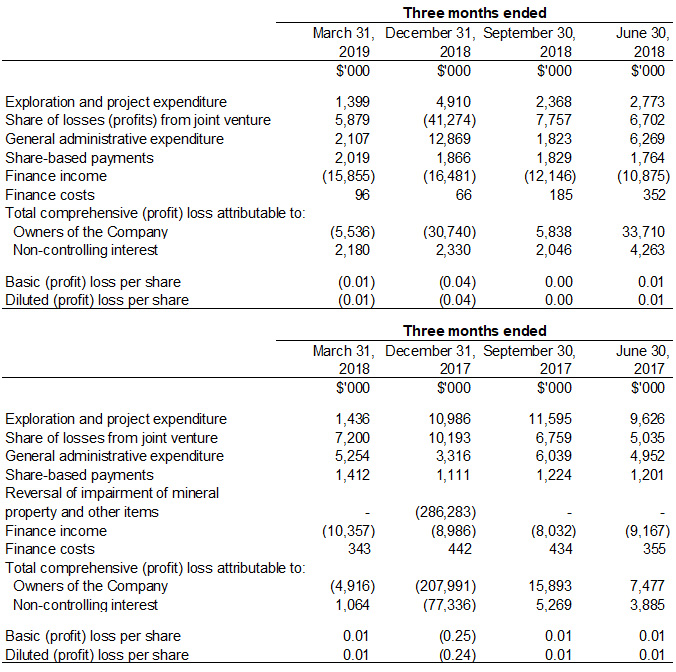
DISCUSSION OF RESULTS OF OPERATIONS
Review of the three months ended March 31, 2019 vs. March 31, 2018
The company recorded a total comprehensive profit of $3.4 million for Q1 2019 compared to a profit of $3.9 million for the same period in 2018. Finance income for Q1 2019, amounted to $15.9 million, and was $5.5 million more than for the same period in 2018 ($10.4 million). The increase mainly was due to interest earned on loans to the Kamoa Holding joint venture to fund operations as the accumulated loan balance increased. This amounted to $12.0 million for Q1 2019, and $8.7 million for the same period in 2018. Interest received on cash and cash equivalents also increased due to a higher cash balance during Q1 2019.
The company’s share of losses from the Kamoa Holding joint venture decreased from $7.2 million in Q1 2018 to $5.9 million in Q1 2019. The following table summarizes the company’s share of the profits and losses of Kamoa Holding for the three months ended March 31, 2019, and for the same period in 2018. The company’s total comprehensive profit for Q1 2018 included an exchange gain on translation of foreign operations of $11.3 million for the three months ended March 31, 2018, resulting from the strengthening of the South African Rand from December 31, 2017, to March 31, 2018, compared to an exchange loss on translation of foreign operations recognized in Q1 2019 of $0.5 million.
Exploration and project expenditure for Q1 2019 was consistent with the expenditure incurred in the same period in 2018 ($1.4 million). With the focus at the Kipushi and Platreef projects being on development and the Kamoa-Kakula Project being accounted for as a joint venture, all exploration and project expenditure in both periods related to exploration at Ivanhoe’s 100%-owned Western Foreland exploration licences.
Financial position as at March 31, 2019 vs. December 31, 2018
The company’s total assets increased by $11.8 million, from $1,884.8 million as at December 31, 2018, to $1,896.6 million as at March 31, 2019. The company utilized $9.2 million of its cash resources in its operations and received interest of $3.3 million during Q1 2019.
The company’s investment in the Kamoa Holding joint venture increased by $20.3 million from $681.7 million as at December 31, 2018, to $701.9 million as at March 31, 2019, with each of the current shareholders funding the operations equivalent to their proportionate shareholding interest. The company’s portion of the Kamoa Holding joint venture cash calls amounted to $14.2 million during the three months ending March 31, 2019, while the company’s share of losses from the joint venture amounted to $5.9 million.
The net increase of property, plant and equipment amounted to $30.2 million, with a total of $31.0 million being spent on project development and to acquire other property, plant and equipment. Of this total, $13.9 million and $17.3 million pertained to development costs and other acquisitions of property, plant and equipment at the Platreef Project and Kipushi Project respectively.
The main components of the additions to property, plant and equipment – including capitalized development costs – at the Platreef and Kipushi projects for the three months ended March 31, 2019, and for the same period in 2018, are set out in the following table:
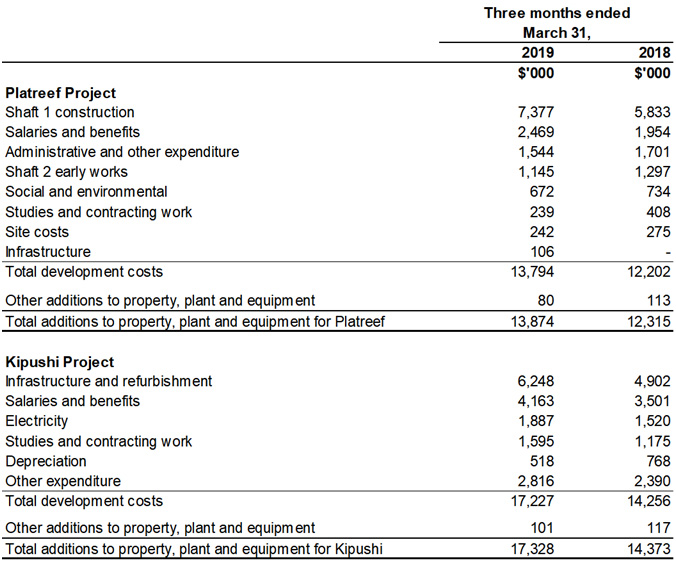
Costs incurred at the Platreef and Kipushi projects are deemed necessary to bring the projects to commercial production and are therefore capitalized as property, plant and equipment.
On adoption of IFRS 16, the company recognized a right-of-use asset of $14.8 million and a lease liability of $15.0 million. The company’s total liabilities increased by $6.4 million to $72.4 million as at March 31, 2019, from $66.0 million as at December 31, 2018, with the recognition of the lease liability being the reason for the increase.
LIQUIDITY AND CAPITAL RESOURCES
The company had $521.6 million in cash and cash equivalents as at March 31, 2019. At this date, the company had consolidated working capital of approximately $515.9 million, compared to $562.9 million at December 31, 2018.
Subsequent to the end of the quarter, in April 2019, Ivanhoe announced that CITIC Metal Co., Ltd. (CITIC Metal), through its subsidiary CITIC Metal Africa Investments Limited (CITIC Metal Africa), has agreed to invest an additional C$612 million (approximately $454 million) in Ivanhoe Mines at C$3.98 per share.
The investment is conditional upon completion of customary, confirmatory due diligence by CITIC Metal and certain internal approvals. It also is subject to approval by the Company’s shareholders, approval by the Toronto Stock Exchange and recordals with certain Chinese regulatory agencies, the latter two of which also were required and obtained for CITIC Metal’s initial investment in Ivanhoe Mines. Receipt of all necessary approvals and completion of the transaction is expected no later than September 7, 2019.
Zijin Mining, which acquired a 9.9% stake in Ivanhoe Mines in 2015 through a wholly-owned subsidiary, will be entitled to exercise its anti-dilution rights through a concurrent private placement at C$3.98 per share, which could result in additional proceeds of up to C$67 million ($49 million).
The Platreef Project’s restricted cash, which were funds of $290 million invested by the Japanese consortium of ITOCHU Corporation, Japan Oil, Gas and Metals National Corporation and Japan Gas Corporation, has been fully utilized and the project’s current expenditure is being funded solely by Ivanhoe as the Japanese consortium has elected not to contribute to current expenditures. Since the Platreef Project’s restricted cash was fully utilized, Ivanhoe has contributed a total of $12.4 million on behalf of the Japanese consortium through an interest bearing loan to Ivanplats.
Since December 8, 2015, each shareholder in Kamoa Holding has been required to fund Kamoa Holding in an amount equivalent to its proportionate shareholding interest. The company is advancing Crystal River’s portion on its behalf in return for an increase in the promissory note due to Ivanhoe.
The company’s main objectives for 2019 at the Platreef Project are the continuation of Shaft 1 construction and the completion of early-works construction of Shaft 2. At Kipushi, the principal objectives are the completion of the feasibility study and continued upgrading of mining infrastructure. At the Kamoa-Kakula Project, priorities are the continuation of development at Kakula and the completion of the feasibility study for Kakula. The company has budgeted to spend $76 million on further development at the Platreef Project; $42 million at the Kipushi Project; $13 million on regional exploration in the DRC; and $22 million on corporate overheads for the remainder of 2019 – as well as its proportionate funding of the Kamoa-Kakula Project, expected to be $87 million for the remainder of 2019. The company will reassess its planned spending for 2019 as a result of CITIC Metal’s additional investment of approximately $454 million.
Subsequent to the end of the quarter, in April 2019, the company extended a secured loan of $50 million to High Power Exploration (HPX), a subsidiary of I-Pulse. The loan has a two-year maturity and an interest rate of 8% per annum, compounding annually. The principal amount of the loan and accrued interest is convertible in whole, or part, by Ivanhoe at its sole discretion into shares of treasury common stock of HPX. The loan is secured by a pledge of shares of an HPX subsidiary in the United States which is pursuing a Tier One copper-gold exploration and development project.
This news release should be read in conjunction with Ivanhoe Mines’ 2019 First Quarter Financial Statements and Management’s Discussion and Analysis report available at www.ivanhoemines.com and at www.sedar.com.
Qualified Person
Disclosures of a scientific or technical nature in this news release have been reviewed and approved by Stephen Torr, who is considered, by virtue of his education, experience and professional association, a Qualified Person under the terms of NI 43-101. Mr. Torr is not considered independent under NI 43-101 as he is the Vice President, Project Geology and Evaluation. Mr. Torr has verified the technical data disclosed in this news release.
Ivanhoe has prepared a current, independent, NI 43-101-compliant technical report for each of the Platreef Project, the Kipushi Project and the Kamoa-Kakula Project, which are available under the company’s SEDAR profile at www.sedar.com:
- The Kamoa-Kakula Integrated Development Plan 2019 dated March 18, 2019, prepared by OreWin Pty Ltd., Amec Foster Wheeler E&C Services Inc. (a division of Wood PLC), DRA Global, SRK Consulting (South Africa) (Pty) Ltd. and Stantec Consulting International LLC, covering the company’s Kamoa-Kakula Project;
- The Platreef 2017 Feasibility Study Technical Report dated September 4, 2017, prepared by DRA Global, OreWin Pty. Ltd., Amec Foster Wheeler, Stantec Consulting, Murray & Roberts Cementation, SRK Consulting, Golder Associates, and Digby Wells Environmental, covering the company’s Platreef Project; and
- The Kipushi 2019 Mineral Resource Update dated March 29, 2019, prepared by prepared by OreWin Pty Ltd., MSA Group (Pty) Ltd., SRK Consulting (South Africa) (Pty) Ltd., and MDM (Technical) Africa Pty Ltd. (a division of Wood PLC), covering the company’s Kipushi Project.
These technical reports include relevant information regarding the effective dates and the assumptions, parameters and methods of the mineral resource estimates on the Platreef Project, the Kipushi Project and the Kamoa-Kakula Project cited in this news release, as well as information regarding data verification, exploration procedures and other matters relevant to the scientific and technical disclosure contained in this news release in respect of the Platreef Project, Kipushi Project and Kamoa-Kakula Project.
Information contacts
Investors
Bill Trenaman +1.604.331.9834
Media
Kimberly Lim +1.778.996.8510
Website www.ivanhoemines.com
Forward-looking statements
Certain statements in this news release constitute “forward-looking statements” or “forward-looking information” within the meaning of applicable securities laws. Such statements and information involve known and unknown risks, uncertainties and other factors that may cause the actual results, performance or achievements of the company, its projects, or industry results, to be materially different from any future results, performance or achievements expressed or implied by such forward-looking statements or information. Such statements can be identified by the use of words such as “may”, “would”, “could”, “will”, “intend”, “expect”, “believe”, “plan”, “anticipate”, “estimate”, “scheduled”, “forecast”, “predict” and other similar terminology, or state that certain actions, events or results “may”, “could”, “would”, “might” or “will” be taken, occur or be achieved. These statements reflect the company’s current expectations regarding future events, performance and results and speak only as of the date of the company’s MD&A Q1 2019.
Such statements include without limitation, the timing and results of: (i) statements that one more station will be developed at a mine-working depth of 950 metres at Shaft 1; (ii) statements regarding Shaft 1 reaching the planned, final depth at 982 metres below surface in early 2020; (iii) statements regarding the timing of Shaft 2 development; (iv) statements regarding the operational and technical capacity of Shaft 1; (v) statements regarding the internal diameter and hoisting capacity of Shaft 2, including that the excavation of the box cut and construction of the hitch foundation is expected to be completed in June 2019, enabling the beginning of the pre-sink, that will extend 84 metres below surface; (vi) statements regarding the Company’s plans to develop the Platreef Mine in three phases: an initial annual rate of four million tonnes per annum (Mtpa) to establish an operating platform to support future expansions; followed by a doubling of production to eight Mtpa; and then a third expansion phase to a steady-state 12 Mtpa; (vii) statements regarding the planned underground mining methods of the Platreef Project including long-hole stoping and drift-and-fill mining; (viii) statements regarding supply of treated water from the town of Mokopane’s new Masodi treatment plant including that it will supply 5 million litres of treated water a day for 32 years; (ix) statements that Ventilation Shaft 2 will be constructed by raise boring and that the shaft will be 5.5 metres in diameter and 200 metres deep; (x) statements regarding the timing, size and objectives of drilling and other exploration programs for 2019 and future periods; (xi) statements regarding exploration on the Western Foreland exploration licences; (xii) statements regarding a definitive feasibility study at the Kipushi Project nearing completion; (xiii) statements regarding the progressive re-commissioning of the turbines, fully refurbished and modernized with state-of-the-art control and instrumentation at Mwadingusha power station, will be completed in Q3 2020 with an output increased to a capacity of approximately 72 megawatts (MW) of power; (xiv) statements regarding timing and completion of the basic engineering design of the plant and surface infrastructure and the underground design at Kakula; (xv) statements regarding expected expenditure for the remainder of 2019 of $76 million on further development at the Platreef Project; $42 million at the Kipushi Project; $13 million on regional exploration in the DRC; and $22 million on corporate overheads – as well as its proportionate funding of the Kamoa-Kakula Project, expected to be $87million for the remainder of 2019; (xvi) statements regarding Platreef projecting it to be Africa’s lowest-cost producer of platinum-group metals; (xvii) statements regarding the construction of a 1,050-metre-level-dam at the Kakula deposit to be commissioned in mid-2019; and (xviii) statements regarding accessing the Kamoa North Bonanza Zone by way of a surface box-cut and decline in a relatively short time-frame; that material mined at Kamoa North could be processed at a nearby, standalone plant, or hauled to the plant that will be constructed at Kakula; and that this has the potential of significantly increasing the copper grades during the initial stages of production at Kamoa-Kakula.
As well, all of the results of the pre-feasibility study for the Kakula copper mine and the updated and expanded Kamoa-Kakula Project preliminary economic assessment, the feasibility study of the Platreef Project and the pre-feasibility study of the Kipushi Project, constitute forward-looking statements or information, and include future estimates of internal rates of return, net present value, future production, estimates of cash cost, proposed mining plans and methods, mine life estimates, cash flow forecasts, metal recoveries, estimates of capital and operating costs and the size and timing of phased development of the projects. Furthermore, with respect to this specific forward-looking information concerning the development of the Kamoa-Kakula, Platreef and Kipushi projects, the company has based its assumptions and analysis on certain factors that are inherently uncertain. Uncertainties include: (i) the adequacy of infrastructure; (ii) geological characteristics; (iii) metallurgical characteristics of the mineralization; (iv) the ability to develop adequate processing capacity; (v) the price of copper, nickel, zinc, platinum, palladium, rhodium and gold; (vi) the availability of equipment and facilities necessary to complete development; (vii) the cost of consumables and mining and processing equipment; (viii) unforeseen technological and engineering problems; (ix) accidents or acts of sabotage or terrorism; (x) currency fluctuations; (xi) changes in regulations; (xii) the compliance by joint venture partners with terms of agreements; (xiii) the availability and productivity of skilled labour; (xiv) the regulation of the mining industry by various governmental agencies; (xv) the ability to raise sufficient capital to develop such projects; and (xiv) political factors.
This news release also contains references to estimates of Mineral Resources and Mineral Reserves. The estimation of Mineral Resources is inherently uncertain and involves subjective judgments about many relevant factors. Estimates of Mineral Reserves provide more certainty but still involve similar subjective judgments. Mineral Resources that are not Mineral Reserves do not have demonstrated economic viability. The accuracy of any such estimates is a function of the quantity and quality of available data, and of the assumptions made and judgments used in engineering and geological interpretation (including estimated future production from the company’s projects, the anticipated tonnages and grades that will be mined and the estimated level of recovery that will be realized), which may prove to be unreliable and depend, to a certain extent, upon the analysis of drilling results and statistical inferences that ultimately may prove to be inaccurate. Mineral Resource or Mineral Reserve estimates may have to be re-estimated based on: (i) fluctuations in copper, nickel, zinc, platinum group elements (PGE), gold or other mineral prices; (ii) results of drilling; (iii) metallurgical testing and other studies; (iv) proposed mining operations, including dilution; (v) the evaluation of mine plans subsequent to the date of any estimates and/or changes in mine plans; (vi) the possible failure to receive required permits, approvals and licences; and (vii) changes in law or regulation.
Forward-looking statements and information involve significant risks and uncertainties, should not be read as guarantees of future performance or results and will not necessarily be accurate indicators of whether or not such results will be achieved. A number of factors could cause actual results to differ materially from the results discussed in the forward-looking statements or information, including, but not limited to, the factors discussed under “Risk Factors” and elsewhere in the company’s MD&A, as well as unexpected changes in laws, rules or regulations, or their enforcement by applicable authorities; the failure of parties to contracts with the company to perform as agreed; social or labour unrest; changes in commodity prices; and the failure of exploration programs or studies to deliver anticipated results or results that would justify and support continued exploration, studies, development or operations.
Although the forward-looking statements contained in this news release are based upon what management of the company believes are reasonable assumptions, the company cannot assure investors that actual results will be consistent with these forward-looking statements. These forward-looking statements are made as of the date of this news release and are expressly qualified in their entirety by this cautionary statement. Subject to applicable securities laws, the company does not assume any obligation to update or revise the forward-looking statements contained herein to reflect events or circumstances occurring after the date of this news release.
The company’s actual results could differ materially from those anticipated in these forward-looking statements as a result of the factors set forth in the “Risk Factors” section and elsewhere in the company’s Q1 2019 MD&A, unaudited condensed consolidated interim financial statements for the three months ended March 31, 2019 and its Annual Information Form.



 English
English Français
Français 日本語
日本語 中文
中文